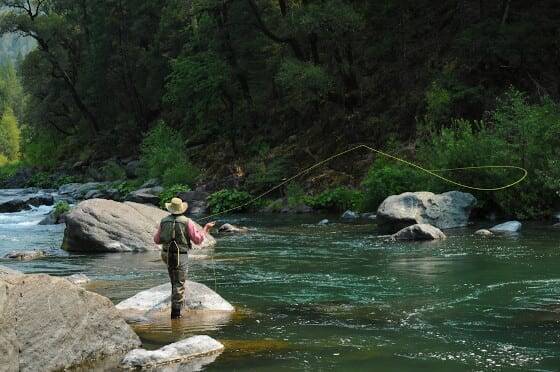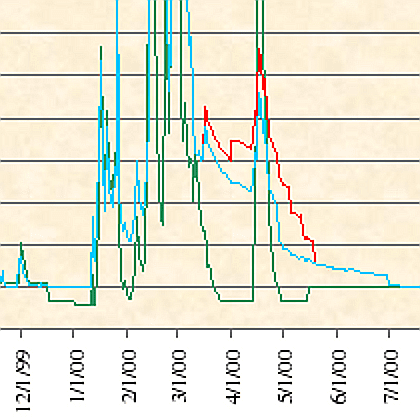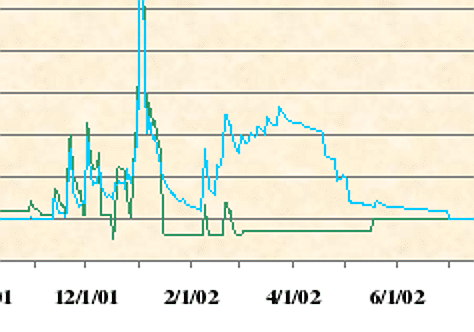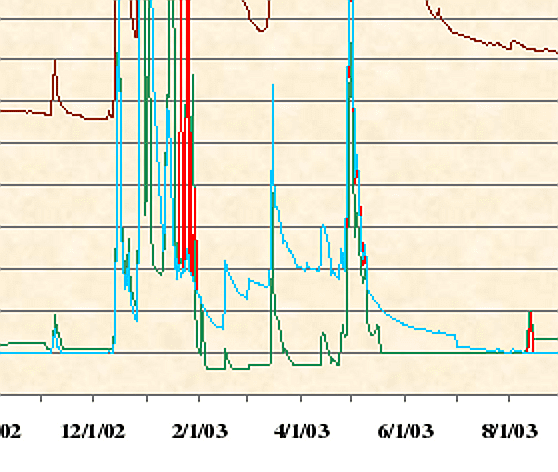The Facts About the McCloud Dam Relicensing Process
Improvements to the fishery, angler access keys to McCloud Dam Hydropower Relicensing process
UPDATE: In addition to this article, we’ve created a five-minute video screencast detailing many of the same issues. Click here to see it.
Impossibly beautiful and imposingly rugged, the McCloud River is known worldwide for its strong, deeply colored rainbow trout. In fact, Northern California’s McCloud River isn’t just a Blue-Ribbon trout river; it’s likely California’s favorite fly fishing destination.

The McCloud River (Val Atkinson photo)
Flows on the the Lower McCloud are controlled by McCloud Dam, which is in the midst of relicensing — the process which will determine how the McCloud’s waters will flow for the next 40-50 years.
Given the McCloud’s importance to fly fishermen, CalTrout was involved from the beginning and played a key role in the relicensing process in partnership with Trout Unlimited and the Northern California Council of the FFF.
Our objectives in this relicensing were to improve the way McCloud Dam release flows are managed in order to:
- Reduce the large flow fluctuations in the winter that impact spawning rainbow trout and habitat
- Eliminate abrupt decreases in flow during spring months that strand newly emerged rainbow trout fry
- Protect the quality angling experience in the McCloud River.
Other groups involved — each with their own specific objectives and regulatory authorities — included PG&E (the dam owner and operator), the US Forest Service, Department of Fish and Game, the State Water Board, whitewater advocacy groups and other fishing groups.
No negotiated solution is ever perfect, but in the case of the McCloud, fly fishermen got what they needed: better flows for fish couched in a flow regime that actually improves the amount of water available to fly fishermen in all but a handful of years.
With these adjustments, the McCloud River will be a healthier river system for now and the long-term.
CalTrout’s Areas of Concern, And How We Addressed Them
Clearly, the McCloud’s trout were already doing well under the current flow regime, and CalTrout’s concerns fell into three key areas:
1) Large-scale spikes (and rapid drops) in winter flows often disrupted spawning fish, exposed redds and harmed insect populations
2) Rapid down-ramping of flows in spring (typically prior to the late-April general trout season opener) also disrupted spawning activities, stranding redds and rainbow trout fry
3) Inadequate flows below McCloud Dam but above Hawkins Creek didn’t afford good fish habitat and recruitment
Our fix? We negotiated hard to see the hydrograph altered in the winter and early spring months to better protect trout populations.
Reading The Hydrograph

McCloud River flows (on all hydrographs, base flow is 100 cfs; every horizontal line represents 100 cfs additional flows)
A hydrograph is a graphic depiction of flows which allows you to easily compare different flow regimes.
The above image represents historic, current, and proposed flow hydrographs on the McCloud River from 10/1999 to 9/2001 (two winters). The large up and down spikes on either end represent two winter periods, where flows are typically highest (and uncertain).
The bottom axis is time (it’s labeled by month), and the left axis is flows (base flow is 100 cfs; each horizontal line represents 100 cfs higher flows).
The upper graph represents inflows into McCloud Reservoir, which do a fair job of representing the McCloud’s historic flows (prior to dam construction and diversion of water in 1965).
The green line represents the existing flow regime, which has supported the McCloud’s excellent fishery to date, but is subject to the shortcomings mentioned above.
The blue line represents our proposed flow regime (with a few small differences, it’s what is contained in the Final EIR).
Comparing flows using a hydrograph is the best way to gain an understanding of what lies ahead for the McCloud’s fly fishermen.
Example 1: Flow Improvements in 2000 (a normal year)

Normal winter/spring flows on the McCloud River, 2000 (base flow is 100 cfs; each horizontal line represents 100 cfs higher flows)
The winter of 99/00 was a “normal to wet” year, and despite its fishability, actually represents the worst case scenario for anglers under the new flow regime; a late spike of spring water (usually caused by precipitation or hot weather) means that on opening day, the McCloud River will be flowing at 300cfs and dropping (at Ah-Di-Nah).
During the recreational flow testing conducted by PG&E, 300 cfs flows were deemed fishable — and even preferable to regular flows — by fly fishing guide Craig Nielsen, who said that while a few spots became inaccessible, more areas in the river held fish.
More importantly, flow regimes like this only occur a couple times a decade; flows will subside more naturally, and provide better habitat for spawning and rearing trout.
The result? Better fishing.
Summary: Under the old flow regime, the mid-March spike in flows is followed by a precipitous plunge to 160 cfs, exposing redds and stranding fry. The proposed flows “stair-step” back to fishable flows, protecting fish yet providing excellent (if not improved) access for fly fishermen.
Example 2: Flow Improvements in 2001 (a dry year)

Dry year flows are designed to protect fish, but won't hamper fishing (base flow is 100 cfs; each horizontal line represents 100 cfs higher flows)
In a dry year (like 2001), the existing flow regime simply doesn’t provide enough “wettable area” (habitat), and while fishermen find access easy, fish populations suffer.
Green Graph (existing): In 2001, the only sizable spike in flows was followed by an immediate plunge to 160 cfs flows (at Ah-Di-Nah). The fall was too rapid to protect fish and insects, and the 160 cfs base flows didn’t provide enough spawning habitat — especially in the stretch above Hawkins Creek.
Blue Line (proposed): Note how flows are maintained during the crucial spawning phase (benefiting fish populations and anglers). Flows under this new scenario would be 300 cfs and dropping by opening day of fishing season.
Summary: In dry years, the proposed flows better protect fish populations, yet still afford excellent angler access.
Example 3: Flow Improvements in 2003 (a wet year)

Anglers will notice few if any differences in access during wet years, but trout will better protected (base flow is 100 cfs; each horizontal line represents 100 cfs higher flows)
Under the old flow regime, January’s high flows were immediately followed by a precipitous decline to 160 cfs flows, which can be catastrophic to spawning fish and fry. Redds are exposed and fry are stranded, and fish populations suffer.
This pattern repeats itself every wet winter, and while it happens largely unnoticed by anglers (who aren’t legally allowed to fish in winter), it takes a toll on the fishery.
Under the proposed flows (the blue line), baseline winter flows would be maintained at a higher levels, so spikes are less pronounced. This offers benefits to the fishery, including:
1) Protects spawning fish and newly emerged fry
2) Protects insect populations from wild fluctuations
3) Doesn’t affect angler access (the river is closed to fishing)
4) Releasing more water in water reduces the likelihood of uncontrolled springtime releases (spikes)
The McCloud Reservoir has little ability to buffer high winter flows, and wet winters — under both old and proposed flows — usually result in high water during the spring. CalTrout’s goal was to buffer the disastrous spiking found in the old flow regime — protecting the fishery — while still ramping flows to fishable levels as soon as was feasible.
Summary: In both dry and wet years, fly fishermen will notice very few differences between the old flow regime and proposed new flows — except that the fishery will be better protected, likely resulting in better fly fishing.
The Subject of “Fishability”
Some have voiced concerns about the new flow regime, some even suggesting the McCloud River would be unfishable for fly fishermen far into the summer months.
Others contend the river is being managed for the benefit of whitewater enthusiasts.
Fortunately, the data disagrees.
In dry and wet years — the vast majority of years — anglers will likely experience little or no difference in terms of fishability or wading access — though they will enjoy the benefits of an improved fishery (better flows = more & bigger trout).
Under the proposed flows, in a handful of years (typically those with large spring spikes in flows), flows will be higher on opening day (last Saturday in April).
This is not a concession to whitewater interests, but an attempt to smooth the transition from high flows to angler-friendly flows. In spring, abrupt transitions can have a catastrophic affect on spawning and rearing trout.
Summary: Better For McCloud’s Fishery
We believe the flows proposed in the Final EIR (and supported by CalTrout, FFF and TU) will improve the health of the McCloud River’s fishery while maintaining – and in some cases improving – angler access.
No negotiated process is ever deemed perfect by all those participating, but in the case of the McCloud Hydropower relicensing, we feel the river’s fishery and angler access will both improve.





6 Comments
Cal Trout,
Thanks for the detailed explination of the proposed flow data for the McCloud. I have fished the McCloud about 3 weeks each year for the past 25 yrs and have been really concerned about the relicensing screwing up my favorite river. On paper the proposal seems sound so will have to wait and see how the river fishes. I am really ticked about the new rafting kyack part of the proposal a Wild River is a Wild River and does not need kyack traffic during fishing season. I have not participated in aCal Trout membership the past couple of years because of the rivers fishablility with the random jacking of flows during testing the past couple of years.
Fred Pendergast
Fred,
Thanks for weighing in. As you can tell by looking at the hydrographs above, there are no rafting/kayaking part of this proposal (contrary to what you may have heard).
We understand your concern about fluctuating flows during the fishing season–we share them. The flows that occurred in 2008 as part of the relicensing study process (and a PG&E malfunction later that same year). Any fluctuations since have been a result of natural runoff patterns rather than dam manipulating flows.
Curtis Knight
California Trout
The information provided sounds good, but the proof will be in the pudding. I have fished the McCloud, spring and fall, for over thirty years, and have found the fluctuating high water flows (employed for the relicensing testing period) during the last couple of years to be frustrating and reasonably unfishable. There is no doubt that rafters on such a small river seriously diminish the serenity, solitude, and closeness to nature experienced when fishing water like that on the conservancy. My biggest peeve, however, is to make a long hike into the conservancy to a favorite run, only to find that a kayaker has decided to pull in and fish it on his way down the river. It has happened.